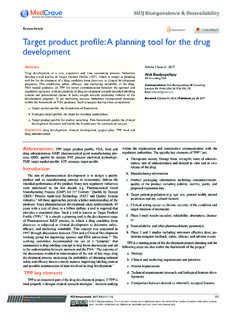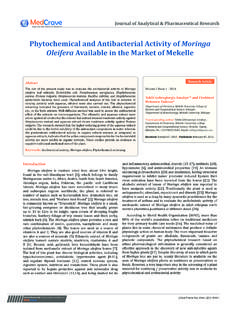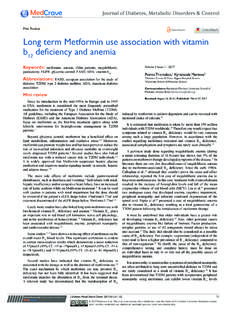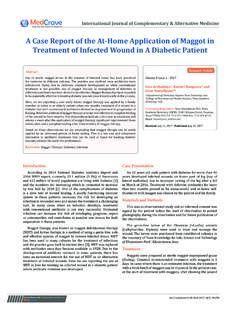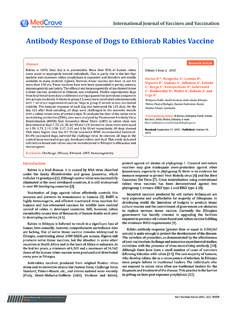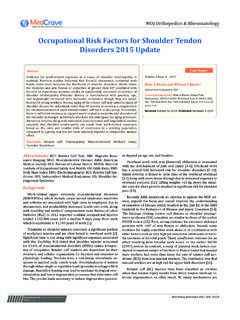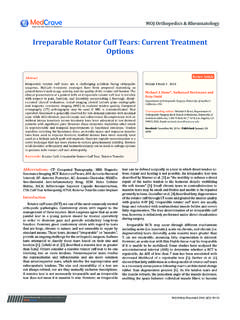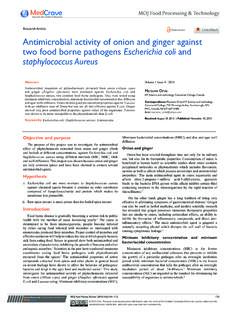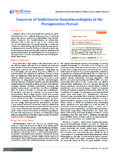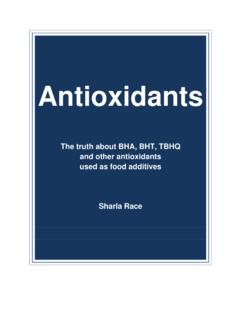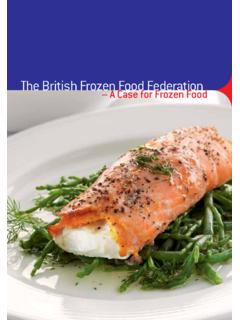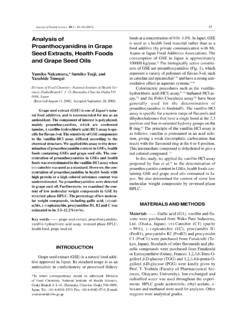Transcription of Potato and Ginger Peels: A potential new source of …
1 Submit Manuscript | : PUFAs, polyunsaturated fatty acids; BHA, butylated hydroxyanisole; BHT, butylated hydroxyl toluene; TBHQ, tertiary butyl hydroquinone; PG, propyl gallate; CGA, cholorogenic acid; CFA, caffeic acid; QNA, quinic acid; FIC, ferrous ion-chelating; FRP, ferric reducing power IntroductionFood products elaborated from fatty fish have lately attracted strong interest on fish processing industry and consumers; this is mainly due to their naturally high content of essential polyunsaturated fatty acids (PUFAs) particularly eicosapentaenoic acid (20:5) and docosahexaenoic acid (22:6).
2 These fatty acids have been shown to have potential benefits for human ,2 Nevertheless, they are susceptible to oxidation to a large extent due to their high degree of unsaturation, which is associated with rancidity and loss in nutritive value of In frozen conditions, marine fish species undergo lipid oxidation and their compounds have shown to facilitate protein denaturation (Mackie, 1993; Sikorski & Kolakowska, 1994), nutritional losses,4,5 and loss of endogenous antioxidant Lipids, especially oxidized lipids, affect the hydrogen bonds and facilitate hydrophobic interactions in proteins foods.
3 Oxidation of lipids initiates other changes in the food system which affects nutritional quality, wholesomeness, safety, color, flavor, and The susceptibility of meat products to oxidation and its subsequent potential hazards in humans has challenged the meat processors and technologists to come up with newer techniques to retard or inhibit oxidation, so as to preserve the quality and enhance the shelf life of such products. antioxidants in food may be defined as any substance which is capable of delaying, retarding or preventing the development of rancidity or other flavor deterioration in Food antioxidants , both synthetic and natural ,9 delay the development of off-flavors by the extension of the initiation period.
4 If antioxidants were added over the reactions leading to initiation of oxidation, it would be ineffective in retarding the rancidity development. HistoryThe term antioxidant (also antioxygen ) originally referred specifically to a chemical that prevented the consumption of molecular oxygen. In the 19th and early 20th century, antioxidants were the subject of extensive research in industrial processes such as the corrosion of metals, explosives, the vulcanization of rubber, and the knocking of fuels in internal combustion , nutrition researchers focused on the use of antioxidants for preventing the oxidative deterioration of unsaturated fats.
5 antioxidants activity was measured by simply placing the fat in a closed glass container with oxygen and observing the rate of oxygen consumption. However, it was the identification of vitamins A, C, and E as antioxidants that revolutionized the field and led to the realization of the importance of antioxidants in biology. Research into how vitamin E prevents the process of lipid per oxidation led to the current understanding of antioxidants as reducing agents that break oxidative chain reactions, often by scavenging reactive oxygen species before they can cause damage to the of action of antioxidantsAntioxidants can inhibit or retard oxidation either by scavenging the free radicals that initiate oxidation or by breaking the oxidative chain reaction.
6 Those that scavenge the free radicals are described as primary antioxidants or chain breaking antioxidants (AH). They scavenge the free radicals (ROO , RO ) as shown in equations 1 and 2 below, and disrupt the propagation step thereby forming an antioxidant radical of such a low reactivity that will lead to no further reaction with the lipids. The resultant antioxidant radical may react either with the hydroperoxide or another antioxidant radical forming a non-radical product.
7 The overall mechanism12 of primary antioxidants is shown below: ROO + AH ROOH + A (1) RO + AH ROH + A (2) A + ROO ROOA (3) A + A non-radical products (4)The primary antioxidants include the phenolic compounds such as BHT, BHA, -tocopherol and other compounds including gallates, nordihydroguairetic acid, flavonoids, aromatic amines, Food Process Technol. 2017;4(5):129 2017 Rashid et al. This is an open access article distributed under the terms of the Creative Commons Attribution License, which permits unrestricted use, distribution, and build upon your work and Ginger peels: a potential new source of natural antioxidantsVolume 4 Issue 5 - 2017 Faisal Rashid,1 Dhanapal K,1 Sravani K 1 Kawkabul Saba21 Department of Fish Processing Technology, College of Fishery science, India2 Department of Fish Resource Management, College of Fishery science, IndiaCorrespondence.
8 Faisal Rashid Sofi, Department of Fish Processing Technology, College of Fisheries, Muthukur, 524344, India, Tel 9676242253, Email November 15, 2016 | Published: July 18, 2017 AbstractSpoilage prevention and shelf-life extension of products will always remain an important goal to the meat industry. While the greatest emphasis is placed on the prevention of microbial spoilage, chemical deterioration, specifically oxidative spoilage, is an important consideration for fresh meats and manufactured meat products as well.
9 In the meat industry especially fish processing, synthetic antioxidants being used for preservation of fish and fishery products. In fact many synthetic antioxidants and antimicrobials are widely used in food and beverage products today and they are safe to consume. Hence the researchers have shifted their focus towards natural antioxidants . The present short review has focus on natural antioxidant and their mode of : spoilage, oxidative, fishery products, beverage products, docosahexaenoic acid, polyunsaturated, eicosapentaenoic acid, fatty acids, unsaturationMOJ Food Processing & TechnologyReview Article Open AccessPotato and Ginger peels: a potential new source of natural antioxidants130 Copyright: 2017 Rashid et : Rashid F, Dhanapal K, Sravani K, et al.
10 Potato and Ginger peels: a potential new source of natural antioxidants . MOJ Food Process Technol. 2017;4(5):129 132. DOI: secondary antioxidants or preventive inhibitors retard the oxidation by deactivating the active species and possible precursors of free radicals by preventive mechanisms viz, binding of metal ions, scavenging of oxygen (equation 7), converting hydroperoxides to non-radical species (equation 6), deactivating singlet oxygen (equation 9), and thereby suppress the generation of free radicals and reduce the rate of oxidation.
